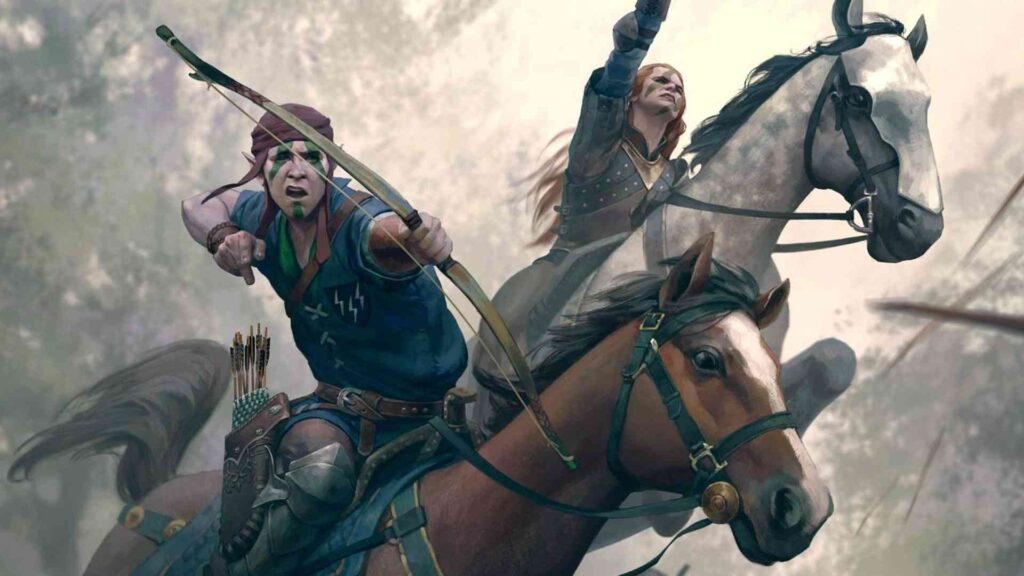The faction offers a nice balance between removal options and engine value, resulting in it being on the stronger side of most metas. Scoia’tael can beat even the strongest decks if played correctly, and that’s why most pro-players decide to include the ST decks in their tourney lineups. The most popular archetypes include harmony, movement, and elves. With harmony being the most successful lately – that’s what we’ll heavily focus on. So let’s talk about which cards are worth crafting if you’re trying to build a competitive deck.
Read more: Crafting Guides
‘¢ Gwent Crafting Guide: Skellige
‘¢ Gwent Crafting Guide: Monsters
‘¢ Gwent Crafting Guide: Neutrals
Contents
Simlas Finn Aep Dabairr
Crafting cost: 800 scraps
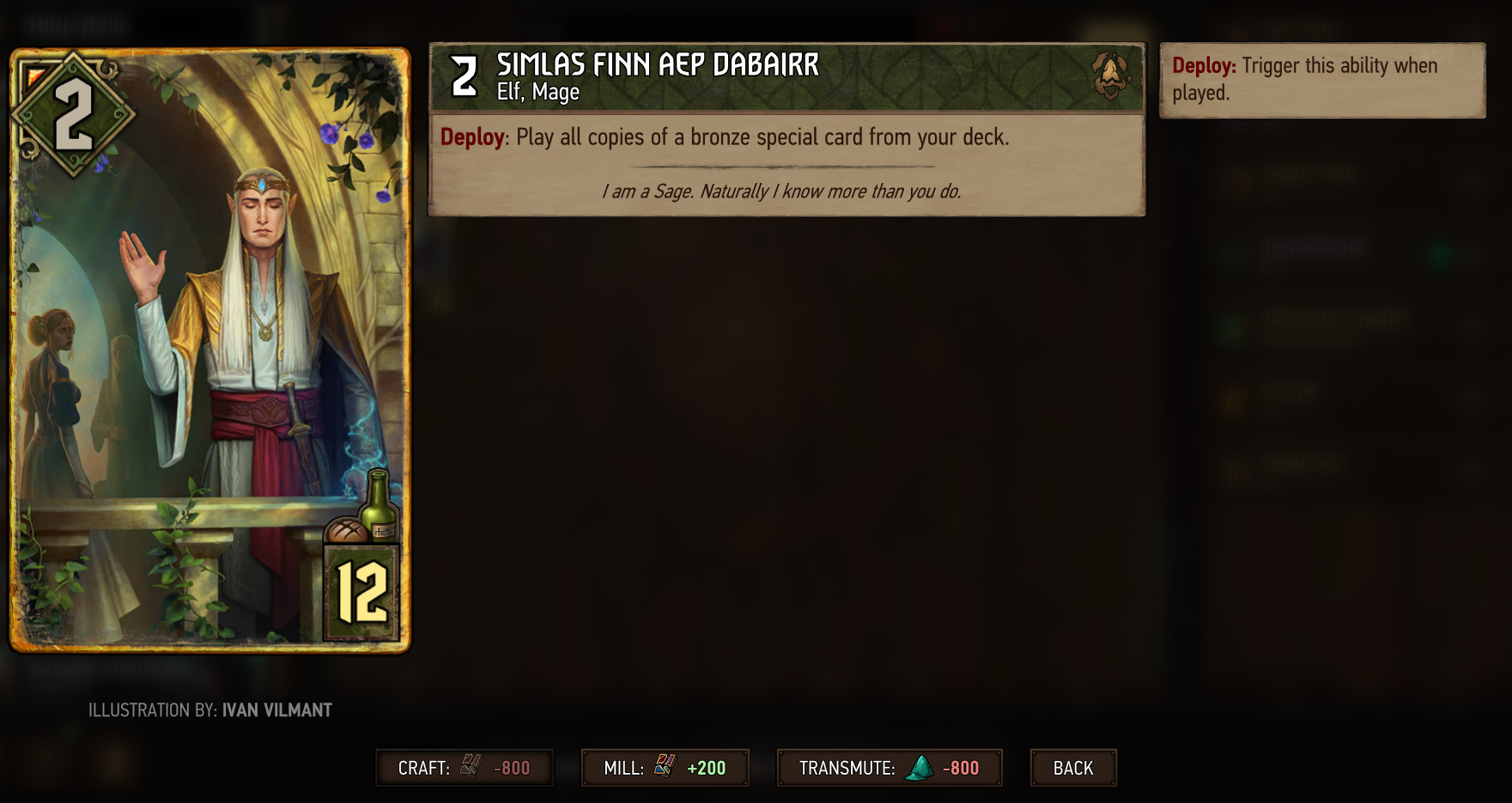 Simlas Finn Aep Dabairr
Simlas Finn Aep DabairrBeing one of Scioa’tael’s most powerful cards, it allows you to play all copies of a special bronze card from your deck. Usually, that means two copies, but certain decks can play even five copies of the same card if navigated correctly. Simlas a powerful play that can easily win a short round, even a card down. The usual target for Simlas is either Bountiful Harvest which allows you to play additional elves and boost units in your hand, or Waylay for control/removal and spawning elves on your side of the board. The truth is Simlas is so strong it fits most Scoia’tael decks, even if their strategy doesn’t revolve around him.
Saskia: Commander
Crafting cost: 800 scraps
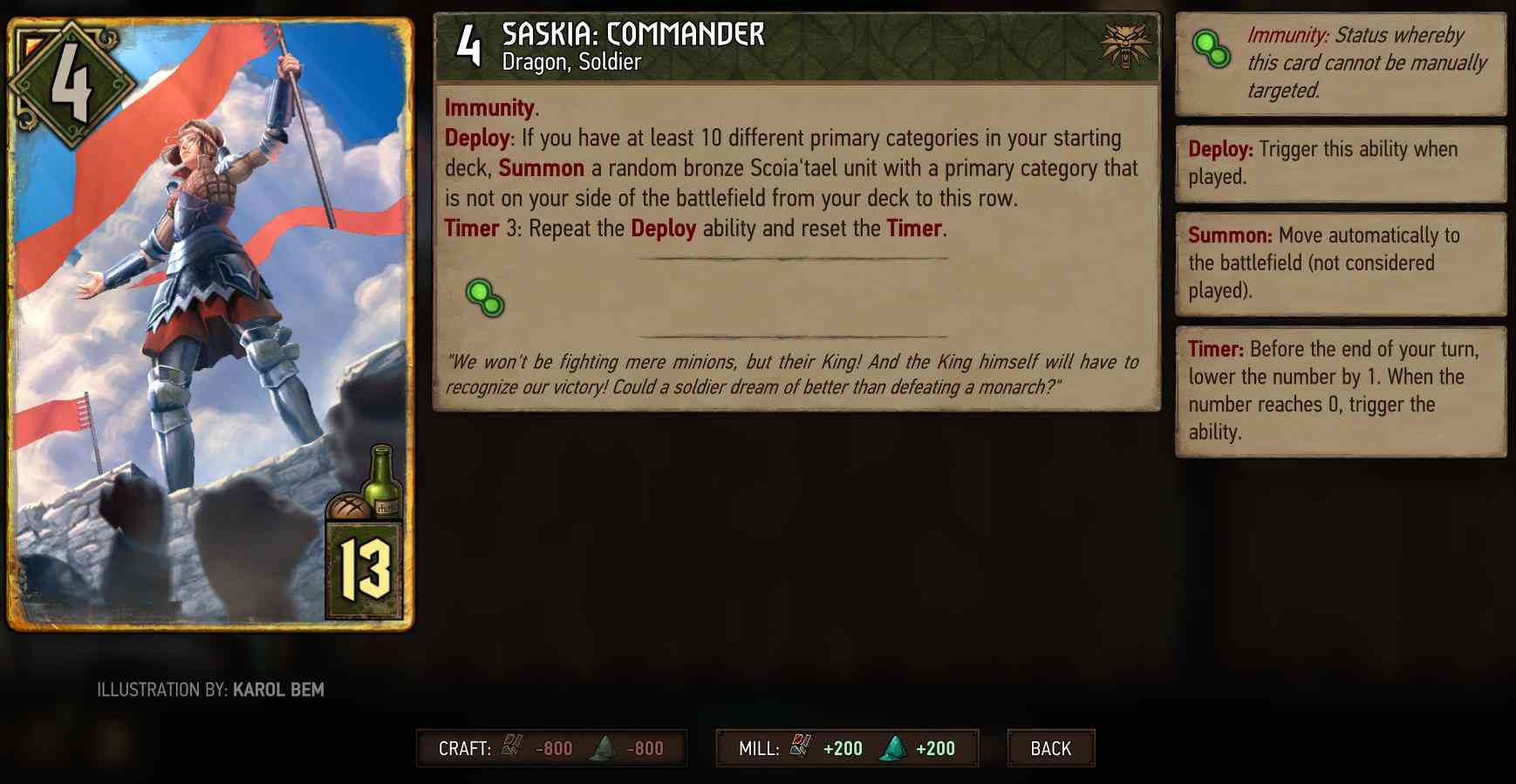 Saskia: Commander
Saskia: CommanderSaskia is a great card that gives you value in more than one way. She pulls units from your deck every few turns, giving you many extra points and allowing you to put more than one unit per turn on your board. This poses a severe engine overload threat for the opponent as it’s hard for him to answer everything. It might be too much for many decks, which wins you the round. Ideally, you want to play Saskia in round 1. This should give you round control because it’s much easier to win with her on the board. Playing her also thins your deck as she pulls out bronze units, meaning you have higher chances of drawing your gold cards. She is so essential in round 1 that many decks decide to run Cursed Scroll as their strategy to ensure they have access to Saskia. The card has immunity which means it can’t be directly targeted and is very hard to answer. The ways of removing her are minimal, and she rarely gets responded to. Just note that she requires specific deckbuilding to work (you need at least ten different primary categories on your cards). Meeting this requirement is not hard, just something to mind when creating the deck. Also, watch for including bronze units that get the most value through their deploy ability – like Dwarven Skirmisher, for example. If your Saskia pulls him from your deck, you miss a lot of points as he is worth just 1 point, which is terrible. So if you plan on playing Saskia, include only bronze units that represent value regardless of how they get to the board. Cards like Antherion, Cat Witcher, or Dryad Matron – to name a few.
Mysteries of Loc Feainn
Crafting cost: 800 scraps
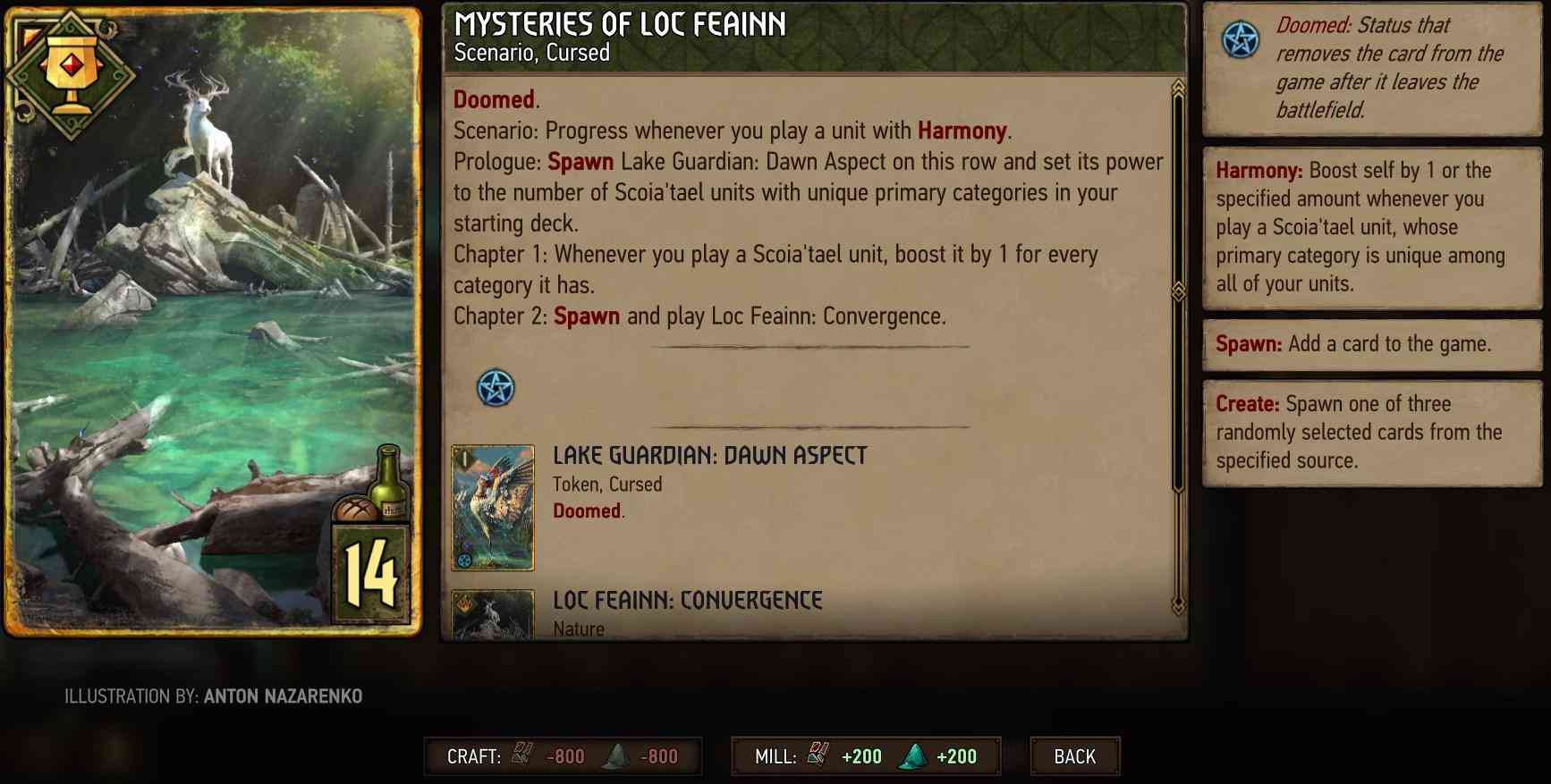 Mysteries of Loc Feainn
Mysteries of Loc FeainnThe most potent tool harmony archetype has at its disposal. This card is expensive in terms of provision but well worth it as it can give you many points. All you need to do is ensure you have at least two harmony units in your hand (or access to them) and enough time for this scenario to steamroll your opponent. A long round is ideal as you can get a lot of value from chapter 1. And even if your scenario gets answered, you are not all that sad as you end up with an eight or 9-power unit on the board and force your opponent to make zero-tempo play with Heatwave.
Lake Guardian: Dusk Aspect
Crafting cost: 200 scraps
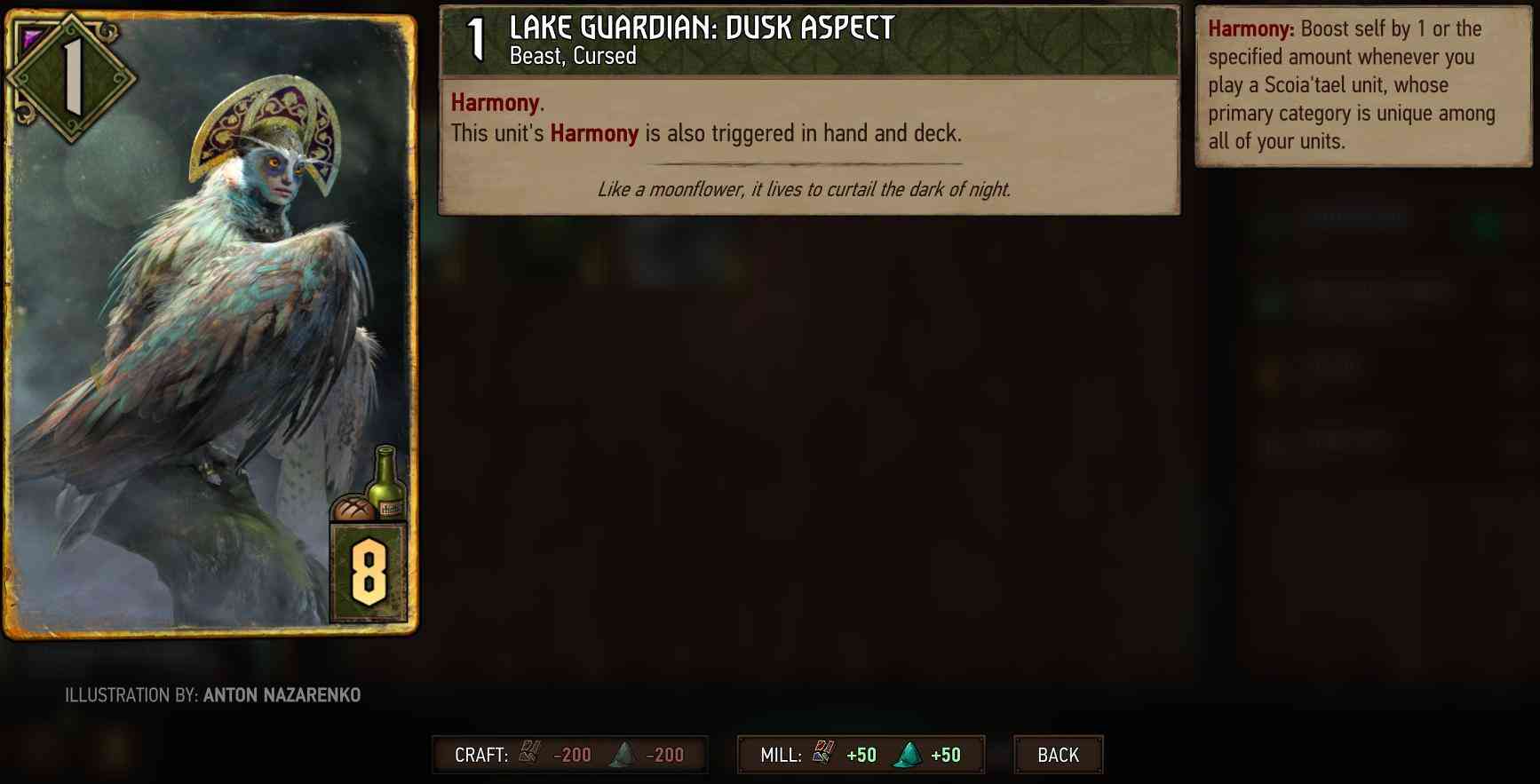 Lake Guardian: Dusk Aspect
Lake Guardian: Dusk Aspect The big finisher harmony is always needed. This harmony engine procs even if it is in your hand or deck. If you are all-in on harmony, it can grow to 15 or 16-points by the end of the match, even more if it gets boosted by cards like Bountiful Harvest. This card makes it viable for harmony decks to go for a short round 3, something they were terrible at before this card was released. It is vulnerable to tall punishment and reset cards, so try to have the last say. Also, note this card keeps growing even when you put it on the board. So in some cases, when you must win round 1, you may consider playing Lake Guardian earlier as it is not bricked; it just represents less value.
Percival Schuttenbach
Crafting cost: 200 scraps
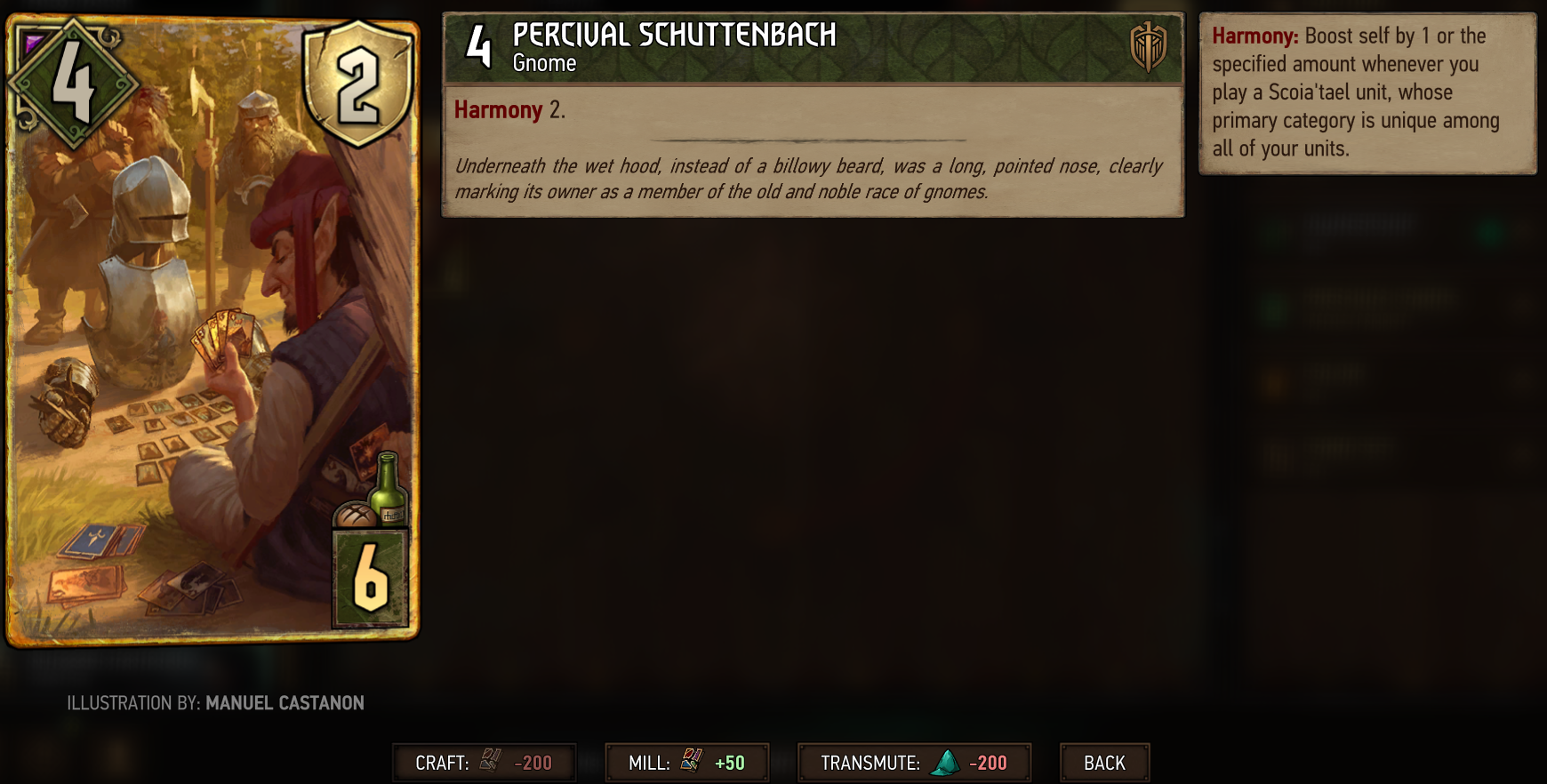 Percival
PercivalThis card is sound because of one main thing – it is cheap. 6-provision card that grows by two with each proc fits any harmony deck. In a long round, it can grow to 20+ points which is crazy for six provisions. Your opponent needs either a lock or six damage to shut down this card which might be expensive for many decks (outside Nilfgaard, obviously). Percival is simply a powerful and cheap engine.
Torque
Crafting cost: 200 scraps
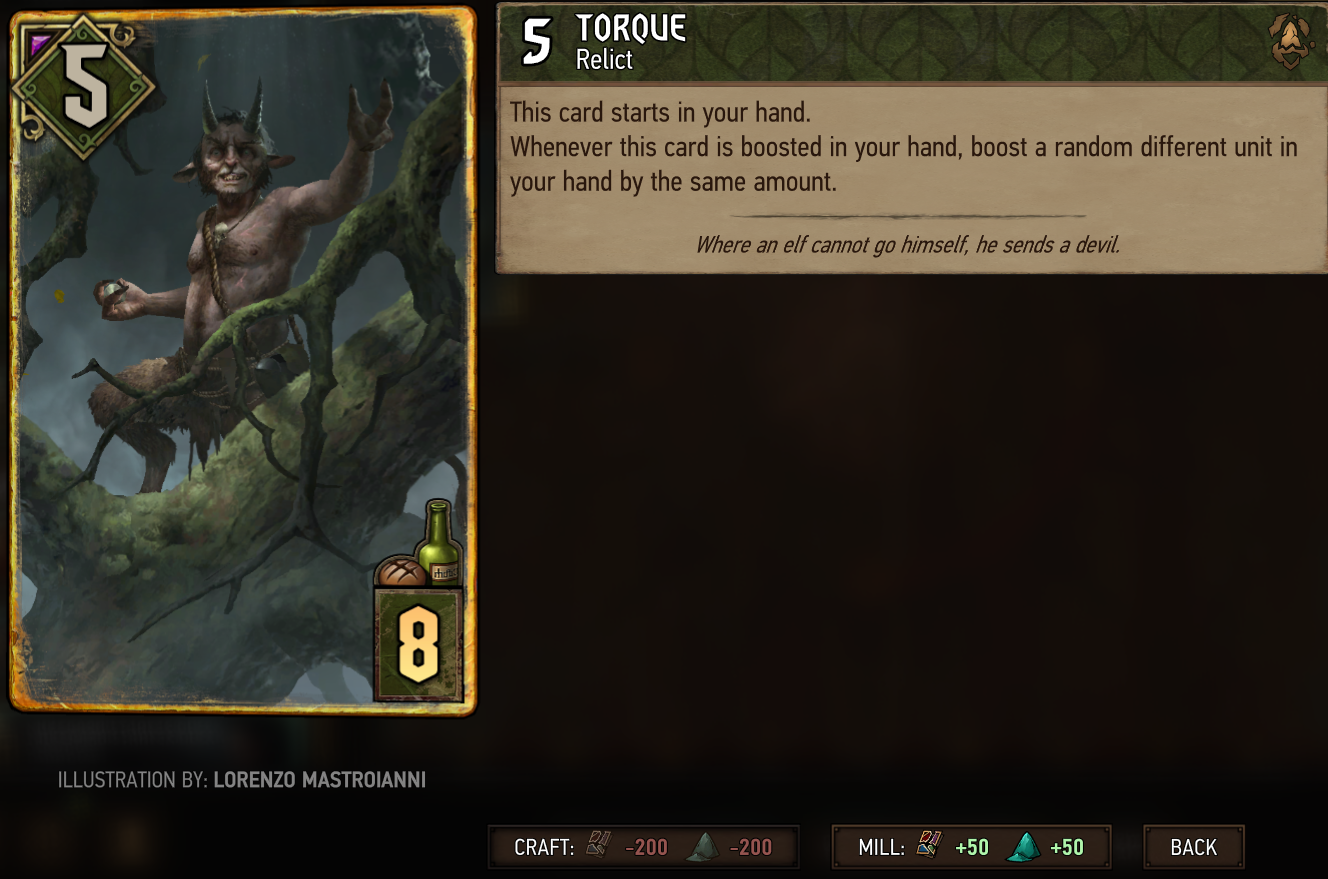 Torque
TorqueTorque is the way to go if you plan on playing the hand buff archetype. It is not the strongest at the moment but very fun. The thrill of ‘where will the buff go’ is unique to handbuff, as is the joy when this huge buff lands on your Sheldon or Aglais. Torque always starts in your hand, so you don’t have to worry about not drawing him. And whenever it gets boosted while in your hand, it randomly boosts another unit for the same amount. Certain plays let you get the most value from this card. One is boosting every card in your hand – except Torque – with your leadership ability and then playing Farseer on your Torque. If done at the start of a first round, it will boost him by 7 or 8 points and give the same boost to another unit in your hand. And when Torque is the most left or right card in your hand, you can boost him with Bountiful Harvest by picking the corresponding unit. Scoia’tael has many ways of hand-boosting units, and your Torque will usually end up at around 20+ points giving your other units some serious buffs.
Antherion
Crafting cost: 80 scraps
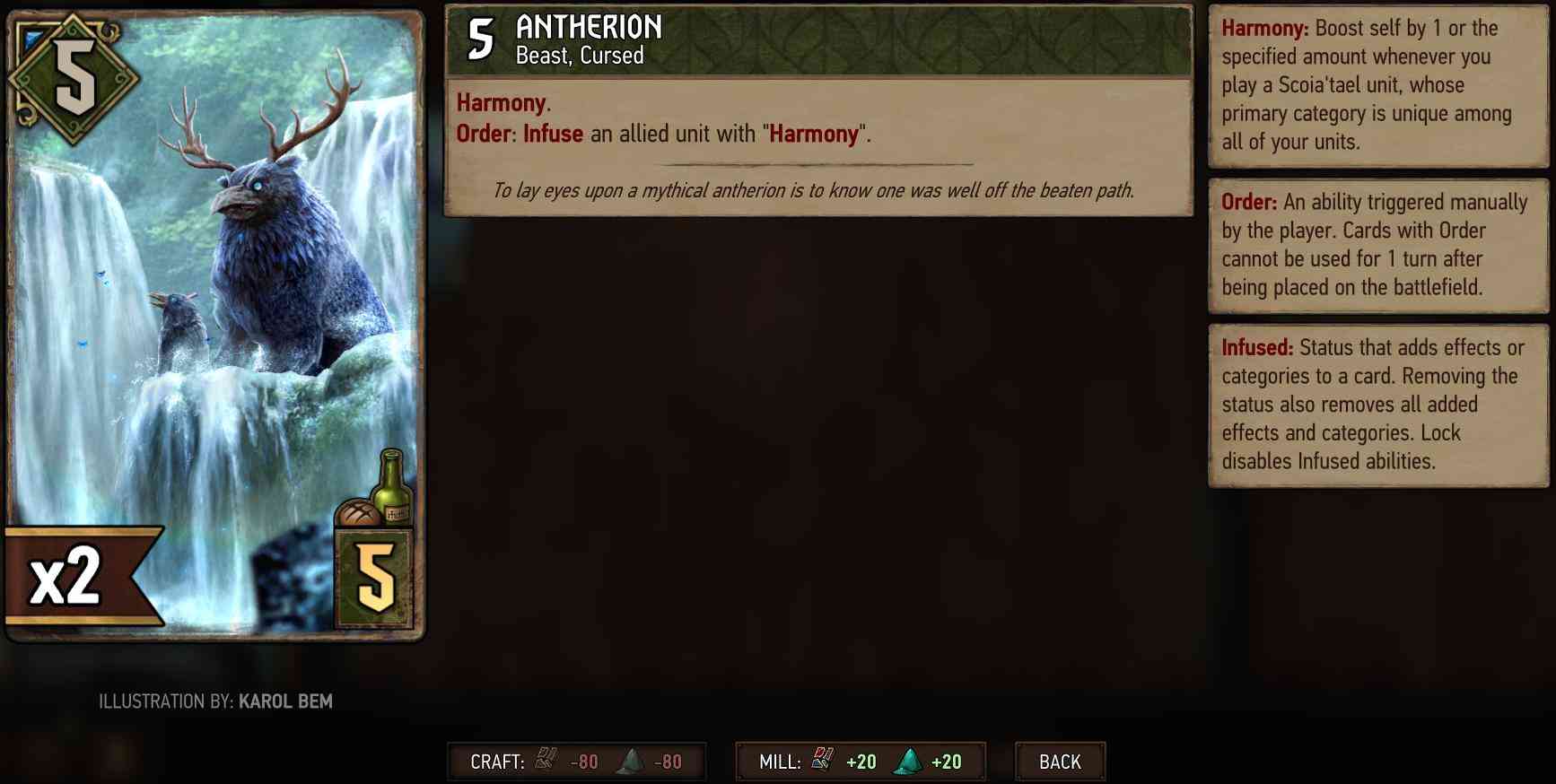 Antherion
AntherionThis card is just a must-have (must-craft?) if you plan on playing the harmony archetype. With five provisions, it offers some great value. The harmony engine allows one to infuse another unit with harmony so effectively that it represents two engines in one card. It is not easy to answer at five power, and even if it gets answered, it means one of your other engines survives. The best thing about Antherion is the fact it is so cheap. Your opponent has to choose whether to use his precious removal/locks on a bronze or let it live, which can give you great value.
Chameleon
Crafting cost: 30 scraps
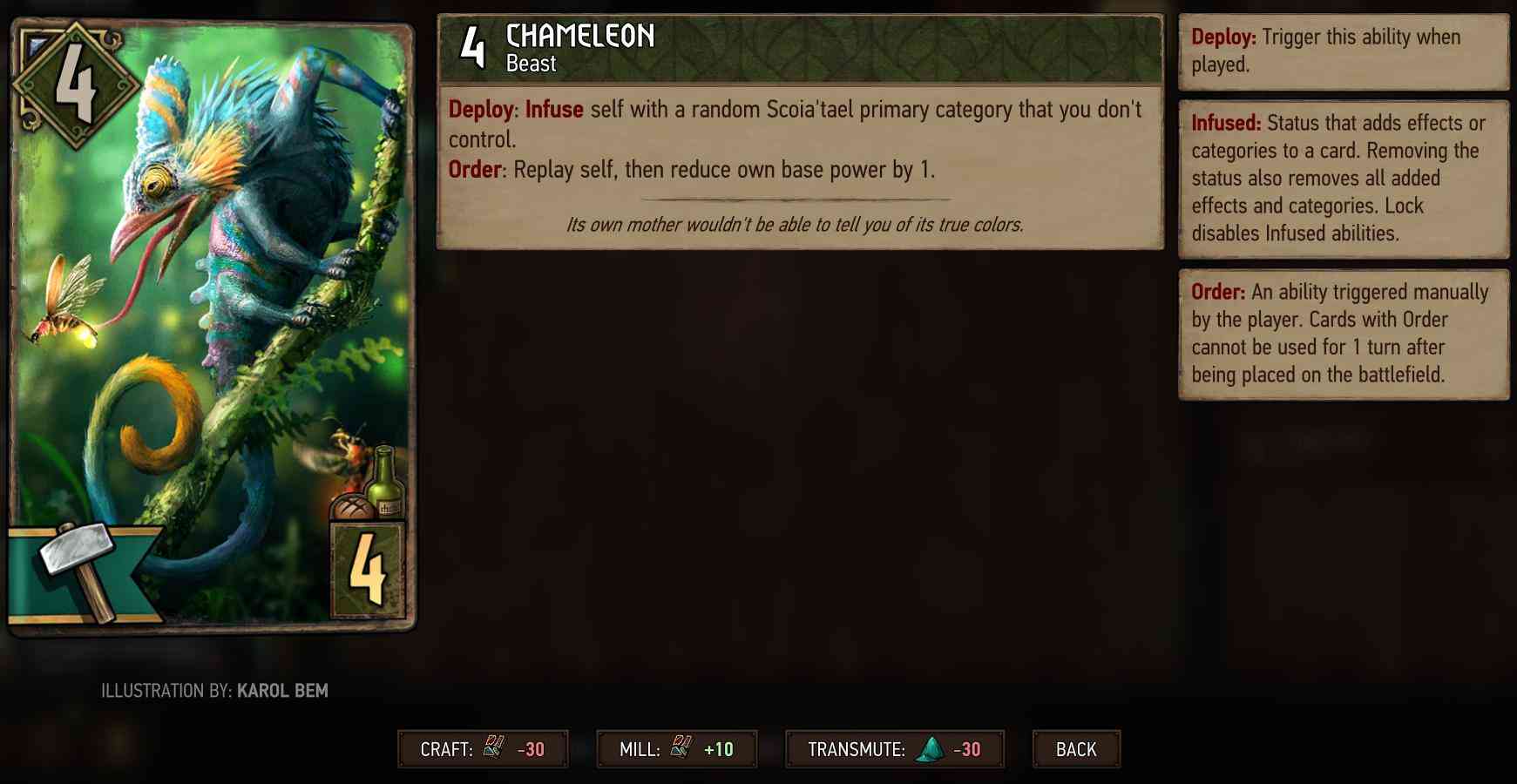 Chameleon
ChameleonAnother important card if you want to play harmony. Very cheap but able to give you insane points. These cards can replay themselves once a turn proccing all of your harmony engines. This effectively means that your every engine can grow two times each turn – once due to Chameleon and once due to your regular card. Or even three times if you control two Chameleons. That is so many points; most decks will have severe problems catching up. The tricky part about Chameleon is knowing when to play him. You don’t want to do it too early as there is nothing to proc but neither too late because Chameleon won’t have enough time to snowball. This card prefers longer rounds – just like the whole harmony archetype.
Bountiful Harvest
Crafting cost: 80 scraps
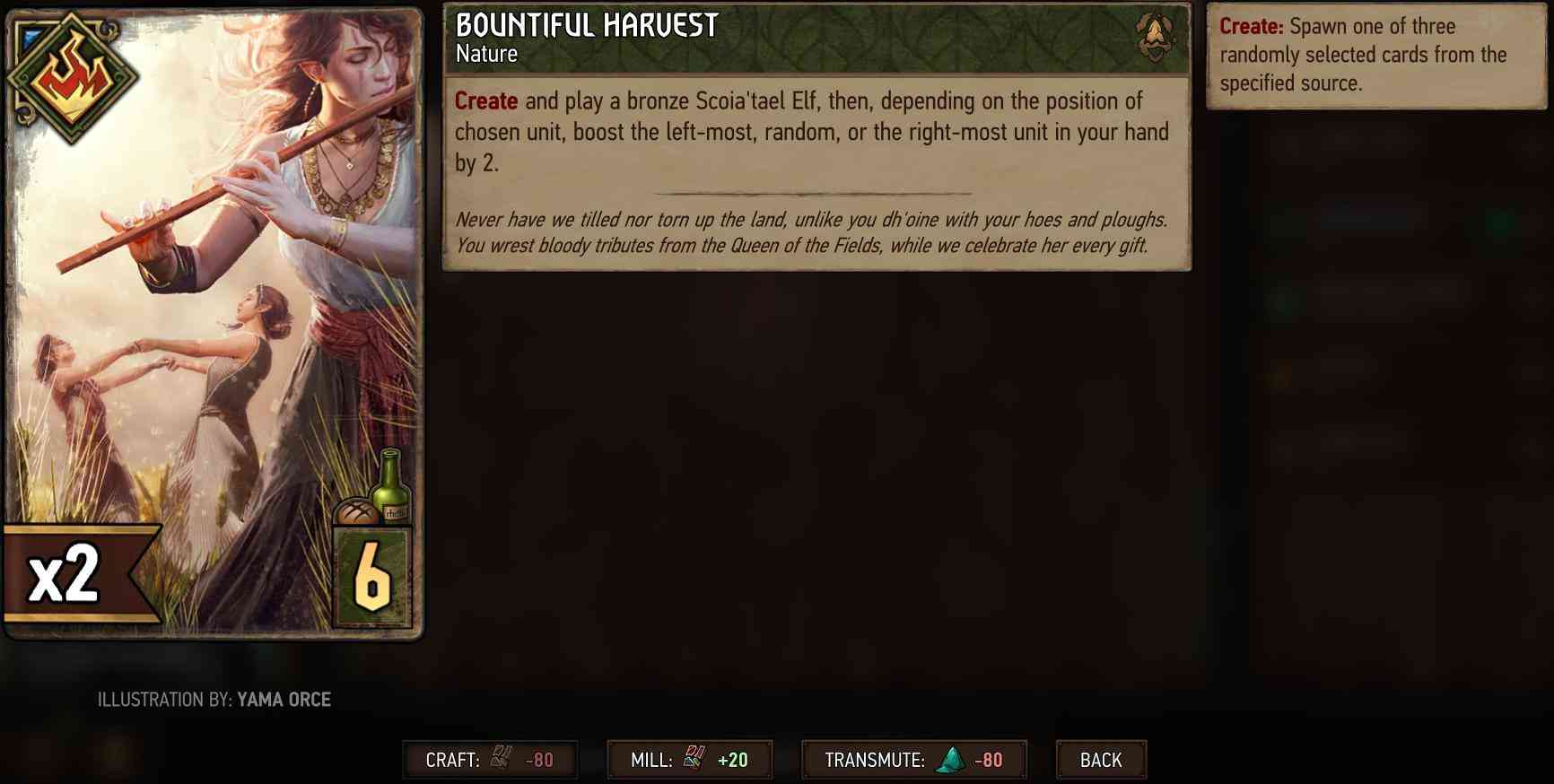 Bountiful Harvest
Bountiful HarvestThis bronze offers great value and provides nice flexibility. Firstly, it allows you to create and play Scoia’tael elf. This gives you options as many bronze elves can serve different purposes – moving units, purifying them, or creating additional specials. You don’t know what you’ll get as you have to pick from three random units, but Bountiful Harvest should give you something decent in most cases. Secondly, this special boosts a unit in your hand, which is the bread and butter of handbuff decks but is helpful in any Scioa’tael deck. Playing two Bountiful Harvests with Simlas enables some great combos. If you’re lucky with your random units, you can get Sorceress of Dol Blathanna and Elven Seer for many additional points. All in all, Bountiful Harvest is just a good bronze that has a lot of utility.


